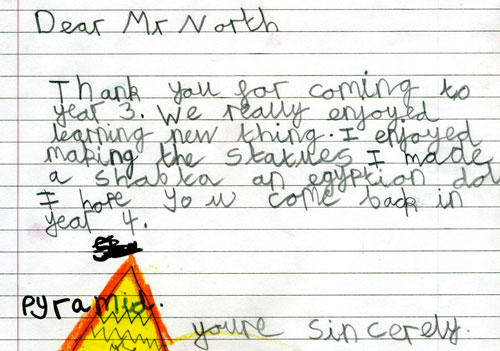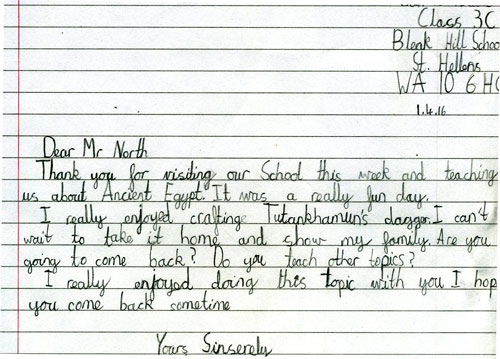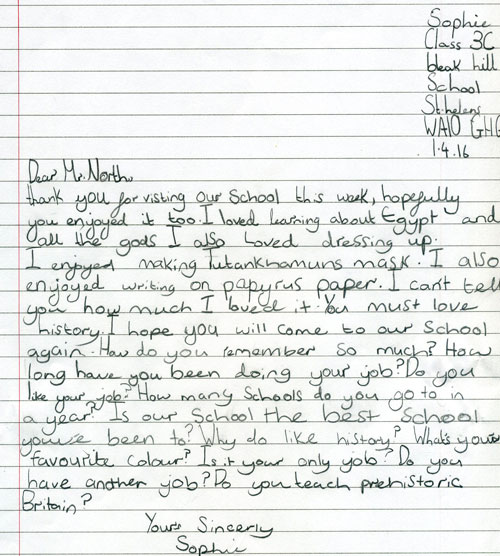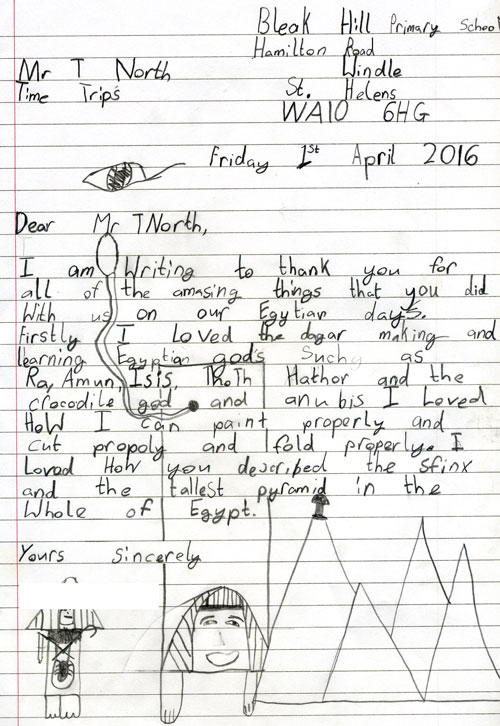
Morning
Option 1 - Gods and Hieroglyphs
-
Learn about 8 of the most important gods, using pictures and a game
-
Learn how to read & write hieroglyphs, write on papyrus
-
Two children dress up as Egyptians
Option 2 - Pyramids
-
Learn about pyramids and how they were built by looking at pictures
-
Three activities - build pyramids with blocks, make a card pyramid (to take home), and use replicas of Egyptian surveying tools
Afternoon
Tutankhamun and the Afterlife
-
Learn about Tutankhamun, and see replicas of his treasure as well as other items related to gods, pharaohs and the afterlife
-
Paint TWO authentic replicas of an Egyptian artefact - a shabti and a scarab beetle. Both of these are also separately available for purchase for £1 each
Detailed lesson plan below
Fee per class for a whole day: £349

|
To book: email Tony North: or tel: 07754 406422 or 0161 224 6445 Maximum 34 children per class |
Pyramid posters and papyrus sheets for sale at workshops
Preparing for the Pharaohs Workshop
Permission Slip for make-up & perfume
Photos from workshops:
St. Agnes CE Primary St. Catherine's
Background information: The Gods Pharaohs Hieroglyphs Pyramids Artefacts Clothing, Make-up etc.
Reviews
'The children had a great time and learnt a lot' (click for more reviews)
Letters from children at Bleak Hill Primary, St. Helens
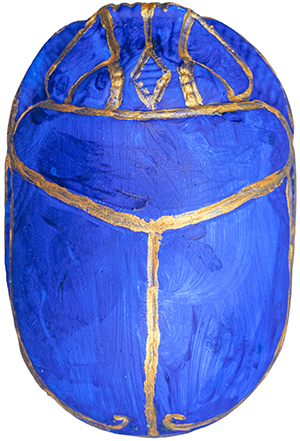
The Wonders of Egypt
There is nowhere on earth like Egypt. For thousands of years tourists have been astounded by its beautiful temples and tombs, its vast pyramids and its golden treasures.
This workshop focuses on what the ancient Egyptians cherished most - their pharaohs and their gods. Most of the amazing sights in Egypt are in some way related to these two. Pyramids were giant rock tombs designed to send the pharaoh up to heaven, and temples were sites of worship for gods, adorned with hieroglyphs proclaiming the greatness of the god and of the pharaoh who built his house.
The Egyptian pyramids were built over 4,000 years ago and over the centuries have inspired as much puzzlement as awe. Why were they built? How could a society with such primitive technology - no iron, no wheels, only stone, wood and copper tools - create monuments which are not only enormous but extremely accurate? The Great Pyramid is the most famous, with over 2 million blocks of limestone, each weighing around 2.5 tonnes, and fitted so well together you can't get a piece of paper between them. Not only that, the greatest difference in length between the four sides (each about 230m) is about 4cm, and the base is level to within 2cm!
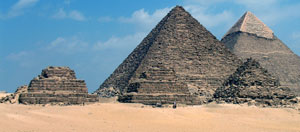
My Egyptian workshop has been very popular since 2004, for several reasons: the enthusiasm and depth of knowledge which I bring to the day, the in-depth tuition on the intricacies of hieroglyphs, art and other aspects of Egyptian culture, the high quality resources and creative activities which children love, and which provide a rich learning experience about ancient Egypt as well as teaching art skills, and the fantastic outcomes which you can display in the classroom.
Detailed lesson plans are provided on this page.
To book, contact:
Tony North
0161 224 6445/07754 406422
Literacy link: for an excellent retelling of Egyptian myths and stories, see Stories from Ancient Egypt by well-known Egyptologist Joyce Tyldesley.

Me (Tony North) teaching
how to read hieroglyphs
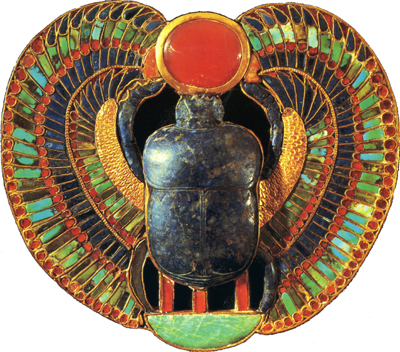
Tutankhamun's scarab pectoral, photo shown in lesson
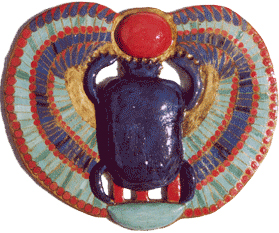
Copy of scarab pectoral shown in the afternoon
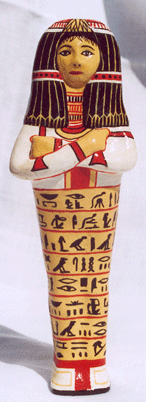
Shabtis (servant statues)
shown in artefacts session


Shabtis painted in the workshop

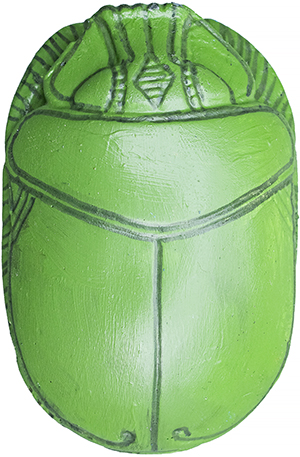
Scarabs painted in the workshop
Morning Option 1 - the Gods: Game, Hieroglyphs and Dress-up
1. Introduction to gods (30-45 mins)
Gods: look at paintings of 8 gods (Anubis, Osiris, Isis, Horus, Hathor, Thoth, Ra, Amun). They learn the gods' names, what they look like, and what they were god of: e.g. Osiris is shown wrapped up as a mummy because he was the ruler of the afterlife, and holding a crook and flail because he was god of farming.

Papyrus painting of Osiris
Next we play a name the god game, looking at 20 photos of gods (paintings or statues) on the interactive whiteboard. Each child takes part using a whiteboard and pen. The children with the highest score get a prize - a poster of the pyramids.
2. Hieroglyphs (60-90 minutes)
Children learn about hieroglyphs, by writing them on a worksheet (see below) and on a piece of real papyrus. They also play reading games, with more papyrus bookmarks for prizes.

Letters - 22 letter hieroglyphs are copied. Children learn that they stand for sounds, which affects how they should write their own names. A game follows in which children read the name of pharaohs (Khufu and Cleopatra) spelled in letters. They will then learn how to write their own names in hieroglyphs.
Words - up to 20 words are copied, including words such as god, king, and lord, as well as words which are parts of pharaohs' names (e.g. ankh in Tutankhamun). A game follows in which children translate hieroglyphs (this section may be omitted if time is short)
Gods' names - children copy the names of 8 gods. A game follows in which photos of hieroglyphs (from tomb or temple walls) are shown on the whiteboard and children have to spot them, with more papyrus bookmark prizes.
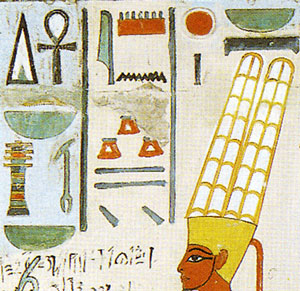
Picture used in the reading games
Write on papyrus - children get a piece of real papyrus paper (6x15cm) and write any hieroglyphs they like (e.g. a pharaoh's name, god's name, their own name). They use a black ink pen, because the Egyptian used black ink.
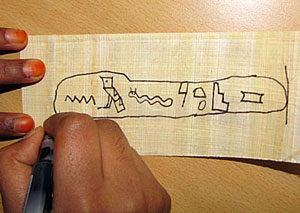
Year 4 child writing on papyrus paper
3. Clothing (15 mins)
One boy and one girl will be chosen to dress up as Egyptians, with linen clothes (a dress for the girl and a kilt for the boy), plaited wigs, jewellery (bracelets and necklaces, including a replica of a princess's collar with over 1,000 beads), eyeliner, and lipstick and blush for the girl. A permission slip will be provided for children to wear the make up.
The children can also try blue lotus perfume (unless they have skin allergies).
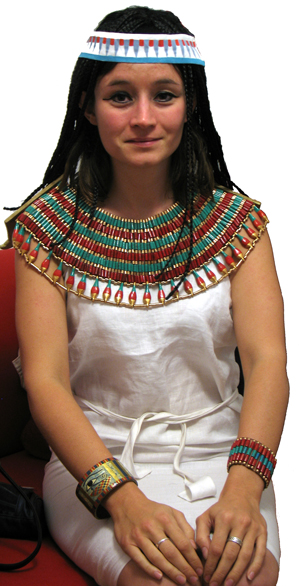
My wife Catherine modelling the clothes, wig and jewellery

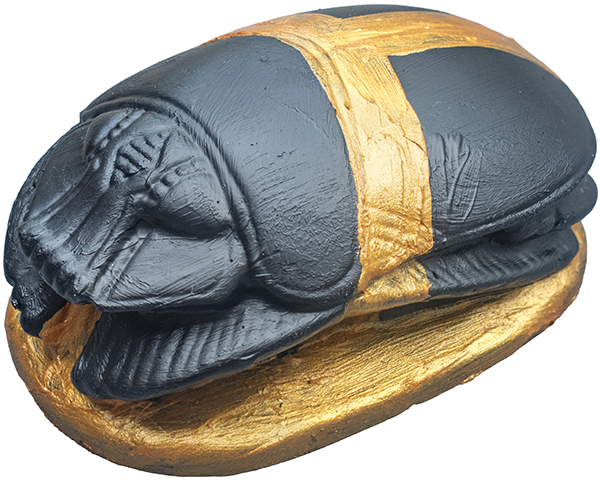
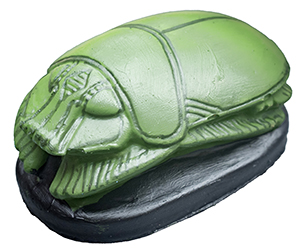
Scarab Beetles painted in the workshop

Shabti painted in the workshop
Morning Option 2 - Pyramids
1. Learn about pyramids (30 mins)
We will look at some pictures of pyramids, the pharaohs who were buried in them, and other images to help children understand what pyramids are, why they were built, and how they were constructed.
2. Experimental archaeology: Three pyramid building activities (90 minutes)
This activity is a fantastic way for children to get a concrete understanding of pyramid building and the difficulties faced by the Egyptians in making these enormous monuments. Archaeologists often find the best way to understand how people of the past did something is to try it themselves. Children will learn from experience in a similar way, using models. They will think about the results of experiments to make conclusions, which we will discuss as a class at the end.
Children are divided into 9 groups and work in rotation on 3 activities (with 3 small groups on each activity at one time). These are:
-
Surveying: using replicas of 3 ancient Egyptian surveying tools (plumb line, level, and set square), children examine surfaces in the classroom to see if they are vertical, horizontal, or right angles. They think about how these tools might have been used to make the pyramid blocks.
-
Making pyramids from card. There are two options. The easier one is to make pyramids from card nets. Children are taught how to cut, fold and glue a card shape to make a replica of the Great Pyramid.
The more difficult option is to make the pyramid from corrugated card (this gives more of a feel for the look of the pyramids). Children draw round a template and cut out the four sides of the pyramid, then sellotape the sides together.
With both options the pyramid is glued onto a card base and the base is painted to look like sand.
Building with blocks: children build their own pyramid from wooden blocks, to try out methods of stacking, and to see how specially shaped casing stones were needed (and what the types of casing stones are), in order to create the original, smooth look of the pyramids.
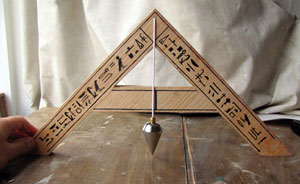
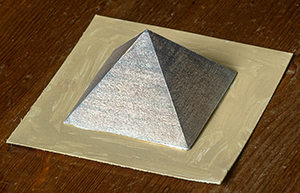


At the end we discuss what children learned about the pyramids from doing these three activities.
Afternoon - Egyptian Artefacts
1. Look at artefacts (15 mins)
Children see a variety of artefacts relating to pharaohs, gods, and the afterlife. The artefacts are copies, some of which I made myself. You can see photos of them on this page and here. This activity teaches children about the items and their meanings, and will inspire them to create their own works of art.
Artefacts include: statuettes (Anubis, a pharaoh, sphinx, scarab beetle, shabti, Tut's coffin, Tut's mask), Tut's scarab pectoral, a pharaoh's bracelet (see below), Tut's dagger, and a relief of a pharaoh and Ra.
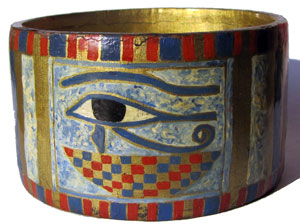
2. Paint Egyptian Artefacts (90 minutes)
I will give a short lesson on how to paint accurately with acrylic paint (e.g. dry brush after washing it, correct mistakes, keep hand steady by resting it on the table, only touch with the tip of the brush).
Then children will make an artefact, painting items with acrylic paint and drawing details with felt tips. There are two types- a scarab beetle and a shabti (servant statue for the afterlife).
If you book a workshop I will email a document to let you know what resources we need (basic things like paint palettes, pots for water, table covers, painting shirts, and paper towels).
The method and materials have been carefully designed so that children can make a replica of high quality. You can see examples I have painted on this page; the unpainted artefacts are below.
Unpainted scarab and shabti
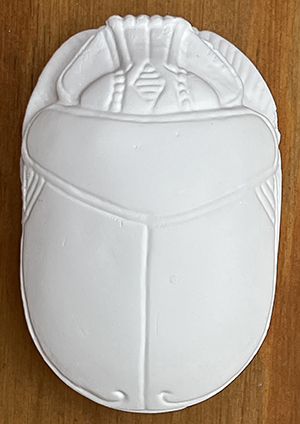
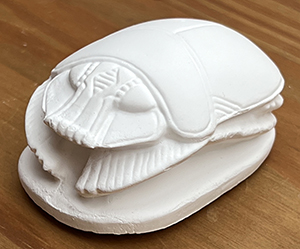

|
Thanks for the brilliant day on Wednesday. All the children learned so much and enjoyed every minute. We can always rely on it being an excellent day and you again didn't disappoint us. |
Kath Phillips, Phase 3 Lead, Thorp Primary, Oldham (March 2020) |
|
The children loved both the workshops and it was a wonderful way to start our topic off. |
Louise Vanes, Y4 teacher, Woodlands Academy, Oldham (Jan 2019) |
|
Hi Tony, my son Harry attended one of your workshops yesterday at Crompton Primary School and thoroughly enjoyed it, in fact he has talked about very little since! So thank you for inspiring him even more in a subject that he has shown so much enthusiasm for already.
|
Parent of Y3 child, Crompton Primary, Oldham (Feb 2019) |
|
We thoroughly enjoyed the Egyptian Workshop yesterday. It allowed those less academic children to shine and excel and express them selves through creative art. The work the children produced was to a very high standard and all children made something and were involved.
|
Lucy Clark, Y5 teacher, Brandwood Primary, Bolton (February 2016) |
|
What a wonderful day! The children all loved learning about Egyptian Fashions. All the children loved it, had so much fun, and learnt so much. |
Linda Kielty, Y4 teacher, St. Clement's CE Primary, Openshaw (May 2015) |
|
Many thanks for a great couple of days. The boys and staff got a huge amount out of it. It has really fired our imaginations. It was super to be able to mix the factual learning with an art activity. The boys were on task and really focussed during these sessions. Thank you. Many thanks again for a superb few days.
|
Oliver Barlow, Y5 teacher, Manchester Grammar School, (June 2014) |
|
Just a quick email to say 'Thank You' for your visit
last week. The children thoroughly enjoyed it and still talk about it
now. It really brought the topic to life and inspired them to carry out
their own research. |
Jane Dempsey, Y5 teacher, Springfield Primary, Burnley (March 2014) |
|
The children had a great day and learnt a
lot. We are hoping to use some of the information in our class assembly
in a few weeks time. Once again thank you for a very interesting and
enjoyable day. |
Emma McMahon, Y4 teacher, Parklee Primary School, Atherton (Nov 2010) |
|
Thank you so much for a fantastic day! All of the class loved it and I did too. Your knowledge of Ancient Egypt is amazing! My nephew is over the moon with your book.
|
Emma Furness, Y3/4 teacher, Norris Bank Primary, Stockport (Oct 2010) |
|
The workshop was amazing the children even now cannot stop talking about it. What I personally liked is the way that you brought to life the Egyptians with your artefacts, paintings and writing. The children liked the hieroglyphic writing, and display which we put together in the hall for all to see is still there and children still look and talk about it. It was one perfect day, I myself learned so much and I thank you for that.
|
Brian Fletcher, Y4 teacher St.Aidan's RC Primary School, Wythenshawe |
|
Very practical, hands on. A fantastic learning experience. All the children and myself found the whole workshop worthwhile and a super learning experience.
|
Year 4 teacher, Queensgate Primary School, Bramhall |
|
Excellent, plenty of variety to interest and stimulate the children.
|
Year 3/4 teacher, Mellor Primary School
|
|
An excellent day. The children particularly enjoyed the practical activities. I liked the variety of activities and the fact that some challenged the children....it has inspired the children when making their own artefacts using clay.
|
Mrs Beswick, Y6 teacher, Seymour Park Primary School, Old Trafford |
|
A great way to introduce the Egyptians. Excellent practical activities that challenged the children. The artefacts made create a great classroom display.
|
Mr Daniels, Y5/6 teacher, Seymour Park Primary School |
|
I thought it was excellent. I enjoyed and the children enjoyed the hieroglyphs and the practical work in the afternoon. A thoroughly enjoyable experience.
|
Mrs Rice, Y5 teacher, Seymour Park Primary School |
|
The children have not stopped talking about yesterday yet! Thank you for the great day, they got so much out of everything!
|
Simon Johnson, St.Luke's Catholic Primary School, Frodsham |
|
Thank
you for a really good Ancient Egypt day last week, the children thoroughly
enjoyed themselves! |
Emma Gallagher, St. Michael's Primary, Flixton |
|
Just to say a big 'thank you' for coming to Hopwood CP School. The children all thoroughly enjoyed your Egyptian Workshop, as did the teachers! We look forward to seeing you again.
|
Gill Cobb, Hopwood CP School, Bury |
|
Once
they've had a Time Trips workshop, they'll keep coming back! |
Gaynor Heck, Holy Trinity Primary School, Hyde
|
Letters from Children at Bleak Hill Primary, St Helens, April 2016

